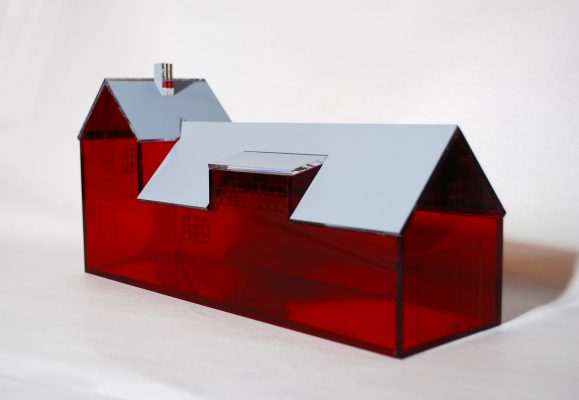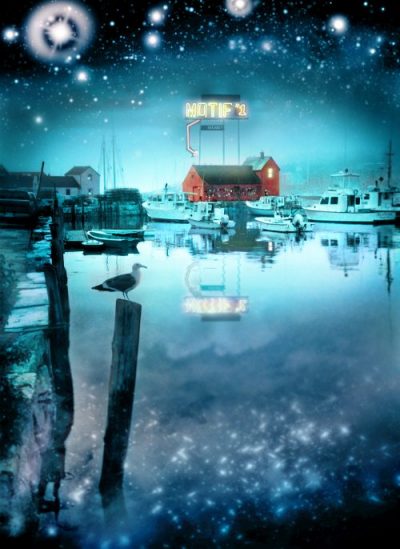the cult of cape ann: iartcolony explores a New England phenomenon

By Olivia J. Kiers
In their recent exhibitions, Rockport, MA gallerists Bob and Jill Whitney Armstrong have pursued an interest in art’s intersection with ritual, talismans and spirituality. On the heels of their summer exhibition at iartcolony, the shaman show, comes the cult of cape ann, a meditation on the power that place can hold over artists. Rather than negative and restrictive, the Armstrongs represent Cape Ann’s “cult” as a romanticized, loosely pagan utopia of nature-based ritual and hippie one-ness.
One-ness aside, the style of artwork in the cult of cape ann is difficult to summarize. For the purposes of this review, I will refer to three main categories or trends, which I’ll call the painterly, the poetic, and the fantastical.
This image: H. Peik Larsen, Quarry, 1999, oil on canvas, 18” x 18″. Previous: Gianna Stewart, MOTIF-0, red and mirrored acrylic, edition 1 of 8, 5.25 x 10 x 3″. All images are courtesy iartcolony.
Painterly works typify the traditional side of Cape Ann’s art ecosystem. They break landscape into visual elements—form, color and light—taking an art-for-art’s-sake stance and celebrating the region’s timelessness. A striking example is H Peik Larsens’s suite of landscapes that celebrate the bold streaks of light and shadow caused by trees, coastlines, and quarries. This version of the “cult” delights in the act of seeing, and at heart it remains close to the en plein air dictum of the American Impressionist tradition, even if it has evolved stylistically.
Krystle Colleen Brown, still from Better Gardens, single channel video, 06:30, loop, edition 1 of 5.
Poetic works relied heavily on words and sound, or employed symbols that suggested elements of Cape Ann history or culture, often overlaid with mystery and emotion. Among these, Krystle Brown’s Better Gardens video follows a woman wandering through the abandoned settlement of Dogtown, where the famous Babson Boulders immortalized by Marsden Hartley are found. Background sounds like insects buzzing and twigs snapping are loud over the headphones as the woman silently lies down on a moss bed, or stops by a ruin. Brown’s work goes hand-in-hand with pieces like Monica Lynn Manoski’s “performance relics and poetry,” presented as a kind of shrine composed of little shelves ensconcing bottles of water and bits of local granite like saintly relics, with label-maker poems running across them and onto nearby doorjambs and windowsills. An excerpt reads: “this place is real / but dissolves inside my head / we were given a map / with wrinkles to follow / to place pins & mark time / but the hours & minutes aren’t linear.” In these works, Cape Ann is more than a visual muse—it’s a psychological place, a site of internal questioning. Of the works on view, these were the most puzzling, yet also the most rewarding to spend time with.
Thomas Philbrook, NUMERO UNO, archival inkjet of a photographic digital composite, image 15 x 21”.
The fantastical works are imaginative homages to Cape Ann icons, with some welcome bursts of humor. The oft-painted red fishing shack known among artists as Motif #1 makes multiple appearances. Thomas Philbrook’s NUMERO UNO is a digitally manipulated scene in which the famous structure sits under a garish, motel-inspired neon sign as a galaxy of stars swirl overhead. It’s Motif #1 as it might appear in Hollywood or Las Vegas. Or maybe a recreation of the shed is destined to travel all the way to Art Basel Miami in 2020, as Gianna Stewart proposes with a fiberglass model and manifesto in MOTIF-0. Stewart acknowledges her project’s absurdity, yet also points out that it has a historical precedent—Rockport artists sent a Motif #1 float to the Chicago World’s Fair in 1933. Motif-0 manages to be both a celebration of an icon, and a hint at this humble buildings strange allure to generations of artists.
For an outsider, Cape Ann’s cult-like attitude about its own art can seem enticing at best, and parochial at worst. Yet for natives and new initiates, the “cult” is a great place to belong. Here, artists are in tune with nature at its most elemental—ocean, rock, sky—while also surrounded by visually interesting human stories, from the travails of working-class fishermen to a booming tourism and leisure industry. It’s the kind of artist group that’s comfortable with its own hyper-localizing tendencies, producing abundant narratives about itself that manage to be both grandiloquent and cozy. All manner of art-making and all levels of talent are welcome—so long as the artist accepts Cape Ann’s incredible power of place.
the cult of cape ann is on view at iartcolony through October 18.



